Experimental Study on Vehicle Pressure Swing Adsorption Oxygen Production Process Based on Response Surface Methodology
Abstract
:1. Introduction
2. Experimental Introduction
2.1. Nitrogen and Oxygen Separation Mechanism
2.2. Oxygen Production Process
2.3. Multi-Factor Experimental Design Based on Response Surface Methodology
3. Results and Discussion
3.1. The Influence of Adsorption Time on Oxygen Production Performance
3.2. The Influence of Pressure Equalization Time and the Pressure Equalization Method on Oxygen Production Performance
3.3. The Influence of Product Gas Flow Rate on Oxygen Production Performance
3.4. The Influence of Oxygen Production Throttling Sub Flow Coefficient on Oxygen Production Performance
3.5. Optimization of Process Parameters Based on Response Surface Methodology
3.5.1. Model Establishment and Analysis
3.5.2. Response Surface and Contour Analysis of Oxygen Production Factors
3.5.3. Optimization of Operating Conditions
4. Conclusions
- (1)
- Through the optimization of single-factor processes, the onboard PSA oxygen production device can produce oxygen at a rate of 2.5 L/min with an oxygen concentration of 93.48%. At this point, the optimal process parameters for the system are: an adsorption time of 5 s, an equalization time of 0.7 s, and a Cv value of 7.58 for the oxygen-producing throttle.
- (2)
- The influence of five different equalization methods on the efficiency of oxygen production through pressure swing adsorption was investigated. The efficiency of oxygen production adheres to the following order: initial upper equalization followed by simultaneous equalization > simultaneous upper and lower equalization > initial lower equalization followed by simultaneous equalization > upper equalization > lower equalization.
- (3)
- Utilizing the response surface methodology, the oxygen production process was optimized. In the course of the experimental study, the influence of four factors on oxygen concentration was found to be in the following order: oxygen production flow rate > adsorption time > equalization time > throttle orifice diameter. Similarly, their impact on the oxygen recovery rate was: oxygen production flow rate > adsorption time > throttle orifice diameter > equalization time. Following optimization under the constraints of maximum oxygen concentration and recovery rate, the oxygen production flow rate reached 2.6 L/min, with an oxygen concentration of 92.11% and an oxygen recovery rate of 44.51%.
Author Contributions
Funding
Data Availability Statement
Conflicts of Interest
References
- Cudaback, D.D. 4-KM Altitude Effects on Performance and Health. Publ. Astron. Soc. Pac. 1984, 96, 580. [Google Scholar] [CrossRef]
- West, J.B. Career perspective: John B West. Extrem. Physiol. Med. 2012, 1, 11. [Google Scholar] [CrossRef] [PubMed]
- Buguet, A. Sleep under extreme environments: Effects of heat and cold exposure, altitude, hyperbaric pressure and microgravity in space. J. Neurol. Sci. 2007, 262, 145–152. [Google Scholar] [CrossRef] [PubMed]
- Kramer, A.F.; Coyne, J.T.; Strayer, D.L. Cognitive function at high altitude. Hum. Factors 1993, 35, 329–344. [Google Scholar] [CrossRef] [PubMed]
- Pagani, M.; Ravagnan, G.; Salmaso, D. Effect of Acclimatisation to Altitude on Learning. Cortex 1998, 34, 243–251. [Google Scholar] [CrossRef] [PubMed]
- West, J.B. Commuting to high altitude: Value of oxygen enrichment of room air. High Alt. Med. Biol. 2002, 3, 223–235. [Google Scholar] [CrossRef]
- Windsor, J.S.; Rodway, G.W. Supplemental oxygen and sleep at altitude. High Alt. Med. Biol. 2006, 7, 307–311. [Google Scholar] [CrossRef]
- Barash, I.A.; Beatty, C.; Powell, F.L.; Prisk, G.K.; West, J.B. Nocturnal oxygen enrichment of room air at 3800 meter altitude improves sleep architecture. High Alt. Med. Biol. 2001, 2, 525–533. [Google Scholar] [CrossRef]
- West, J.B. Oxygen enrichment of room air to relieve the hypoxia of high altitude. Respir. Physiol. 1995, 99, 225–232. [Google Scholar] [CrossRef]
- Ruthven, D.M.; Farooq, S. Air separation by pressure swing adsorption. Gas Sep. Purif. 1990, 4, 141–148. [Google Scholar] [CrossRef]
- Rumbo Morales, J.Y.; Ortiz-Torres, G.; García, R.O.D.; Cantero, C.A.T.; Rodriguez, M.C.; Sarmiento-Bustos, E.; Oceguera-Contreras, E.; Hernández, A.A.F.; Cerda, J.C.R.; Molina, Y.A.; et al. Review of the Pressure Swing Adsorption Process for the Production of Biofuels and Medical Oxygen: Separation and Purification Technology. Adsorpt. Sci. Technol. 2022, 2022, 3030519. [Google Scholar] [CrossRef]
- Chin, C.; Kamin, Z.; Bahrun, M.H.V.; Bono, A. The production of industrial-grade oxygen from air by pressure swing adsorption. Int. J. Chem. Eng. 2023, 2023, 2308227. [Google Scholar] [CrossRef]
- Niu, H.; Tian, L.; He, Y.; Ding, J. High altitude oxygen production and implementation of special vehicle. In Proceedings of the Man-Machine-Environment System Engineering: Proceedings of the 18th International Conference on MMESE 18, Nanjing, China, 20–22 October 2018; Springer: Berlin/Heidelberg, Germany, 2019. [Google Scholar]
- Song, L.; Zhao, Y.; Yan, L.; WU, Q.; MA, L. Development of vehicle-mounted medical PSA oxygen generation system for driver on plateau. Chin. Med. Equip. J. 2007, 28, 18–21. [Google Scholar]
- Ze-Dong, Y.; Shuai, S.; Guang-Hao, S.; Juan, L.; Kang-Ning, X.; Jing, D.; Er-Ping, L. Evaluation on application effect of onboard membrane separation oxygen generator at high altitude. Chin. Med. Equip. J. 2016, 37, 13–15. [Google Scholar]
- Bahgat, E.A.; Hafez, H.M.; El-Sayed, H.M.; Kabil, N.A.S. Development of a solvent-free micellar HPLC method for determination of five antidiabetic drugs using response surface methodology. Microchem. J. 2022, 179, 107446. [Google Scholar] [CrossRef]
- Li, J.; Jasim, D.J.; Kadir, D.H.; Maleki, H.; Esfahani, N.N.; Shamsborhan, M.; Toghraie, D. Multi-objective optimization of a laterally perforated-finned heat sink with computational fluid dynamics method and statistical modeling using response surface methodology. Eng. Appl. Artif. Intell. 2024, 130, 107674. [Google Scholar] [CrossRef]
- Shahidi, S.A. Effect of solvent type on ultrasound-assisted extraction of antioxidant compounds from Ficaria kochii: Optimization by response surface methodology. Food Chem. Toxicol. 2022, 163, 112981. [Google Scholar] [CrossRef]
- Anamu, U.S.; Olorundaisi, E.; Ayodele, O.O.; Babalola, B.J.; Odetola, P.I.; Ogunmefun, A.; Ukoba, K.; Jen, T.C.; Olubambi, P.A. Process Optimization of Spark Plasma Sintered Parameters for Ti-Al-Cr-Nb-Ni-Cu-Co High Entropy Alloy by Response Surface Methodology. Mater. Sci. Forum 2024, 1116, 85–94. [Google Scholar] [CrossRef]
- Lu, A.-H.; Deng, C.; Zhu, M.-F.; Deng, Y.; Shi, M.-S.; Ma, J.; Gao, W.-Y. Analyzing the PSA process of oxygen generation in plateau environment using response surface method. Appl. Chem. Ind. 2018, 47, 1175–1178. [Google Scholar]
- Chen, W.-H.; Chen, W.-H.; Chein, R.-Y.; Hoang, A.T.; Manatura, K.; Naqvi, S.R. Optimization of hydrogen purification via vacuum pressure swing adsorption. Energy Convers. Manag. X 2023, 20, 100459. [Google Scholar] [CrossRef]
- Zhang, N.; Benard, P.; Chahine, R.; Yang, T.; Xiao, J. Optimization of pressure swing adsorption for hydrogen purification based on Box-Behnken design method. Int. J. Hydrogen Energy 2021, 46, 5403–5417. [Google Scholar] [CrossRef]
- Zhu, X.; Sun, Y.; Liu, Y.; Sun, X.; Shi, J. Experimental performance analysis of vacuum pressure swing adsorption air separation process under plateau special conditions. Sep. Sci. Technol. 2022, 57, 2885–2893. [Google Scholar] [CrossRef]
- Zhang, Q.; Liu, Y.; Li, Z.; Xiao, P.; Liu, W.; Yang, X.; Fu, Y.; Zhao, C.; Yang, R.T.; Webley, P.A. Experimental study on oxygen concentrator with wide product flow rate range: Individual parametric effect and process improvement strategy. Sep. Purif. Technol. 2021, 274, 118918. [Google Scholar] [CrossRef]
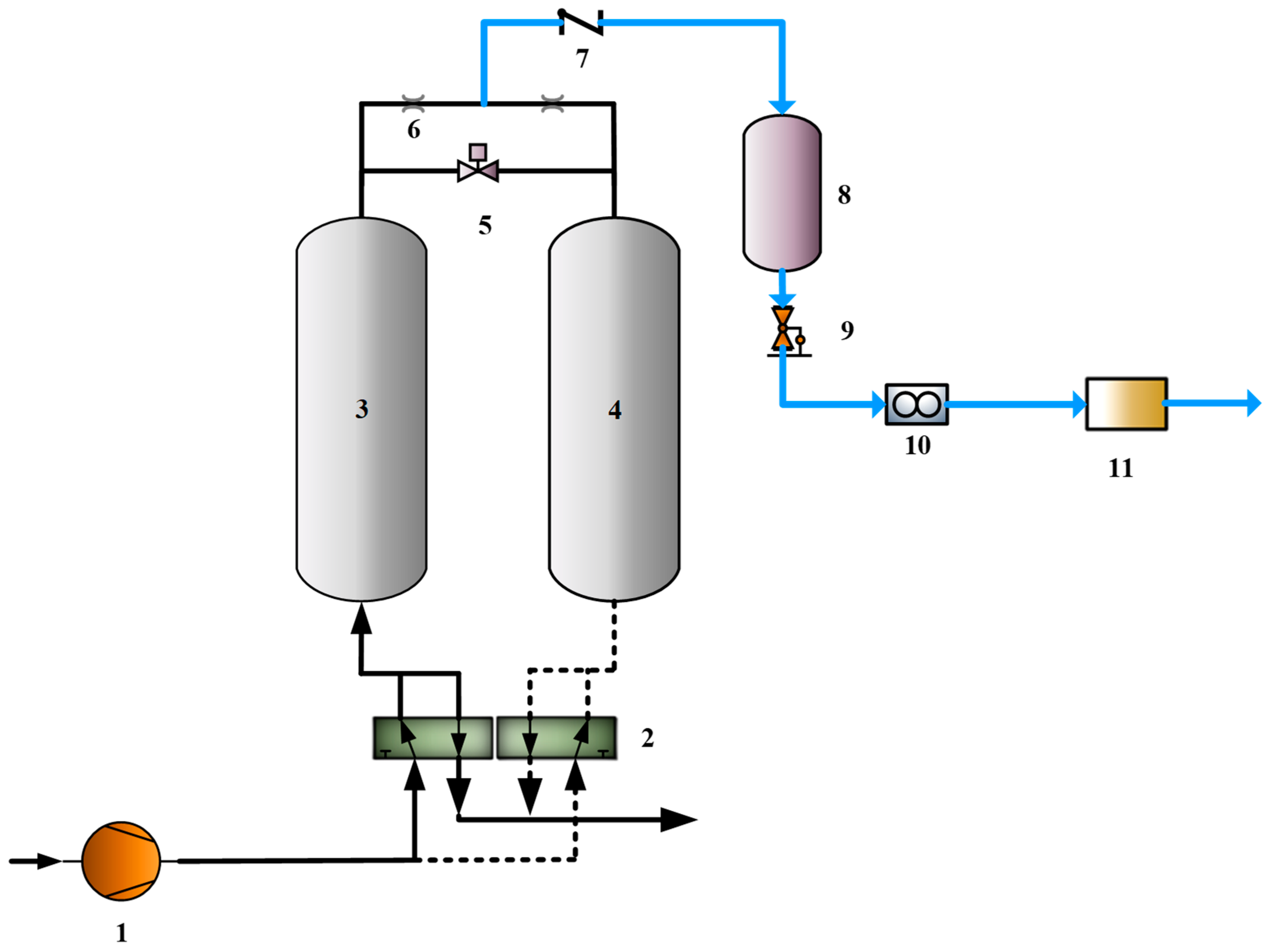



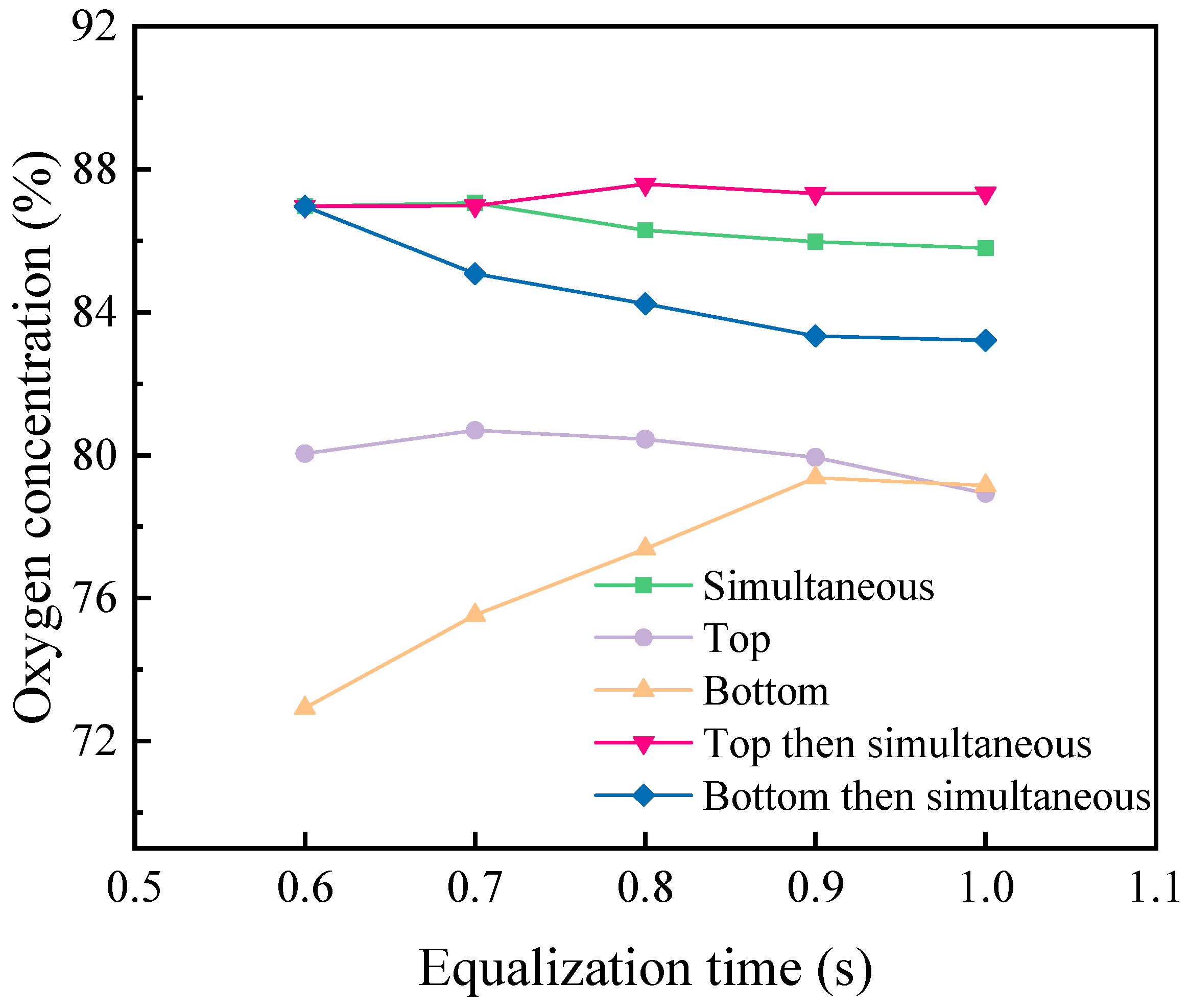

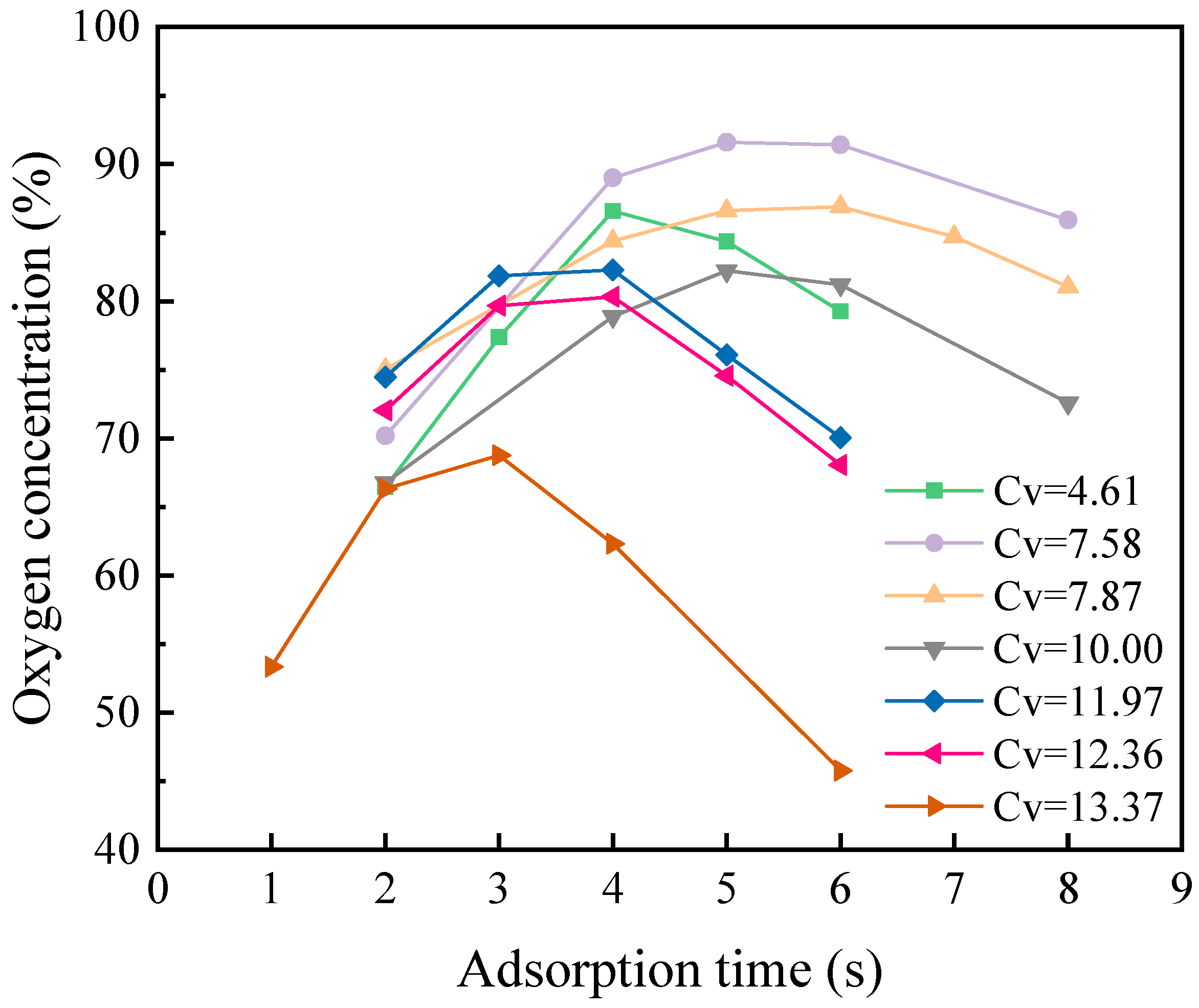

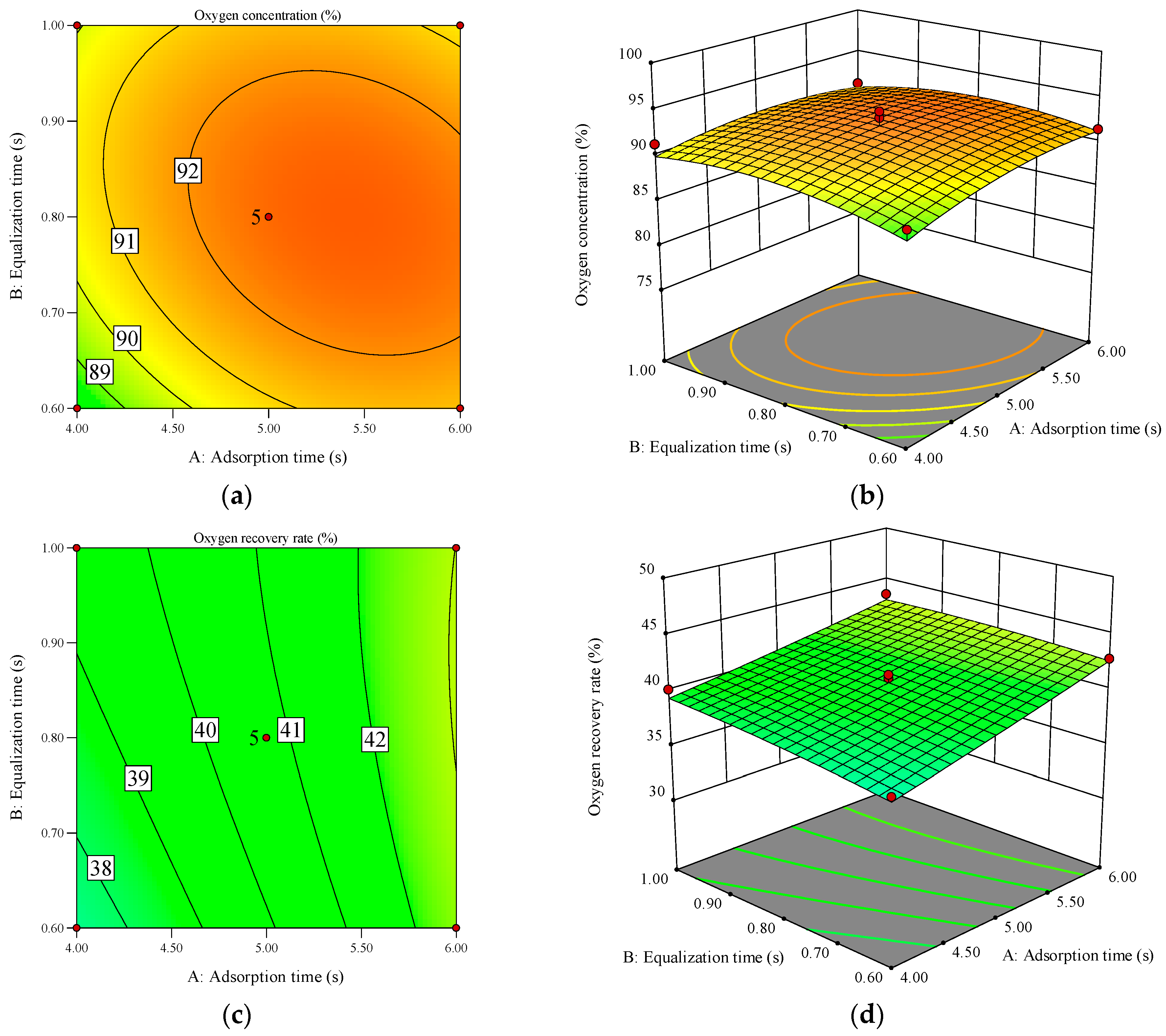
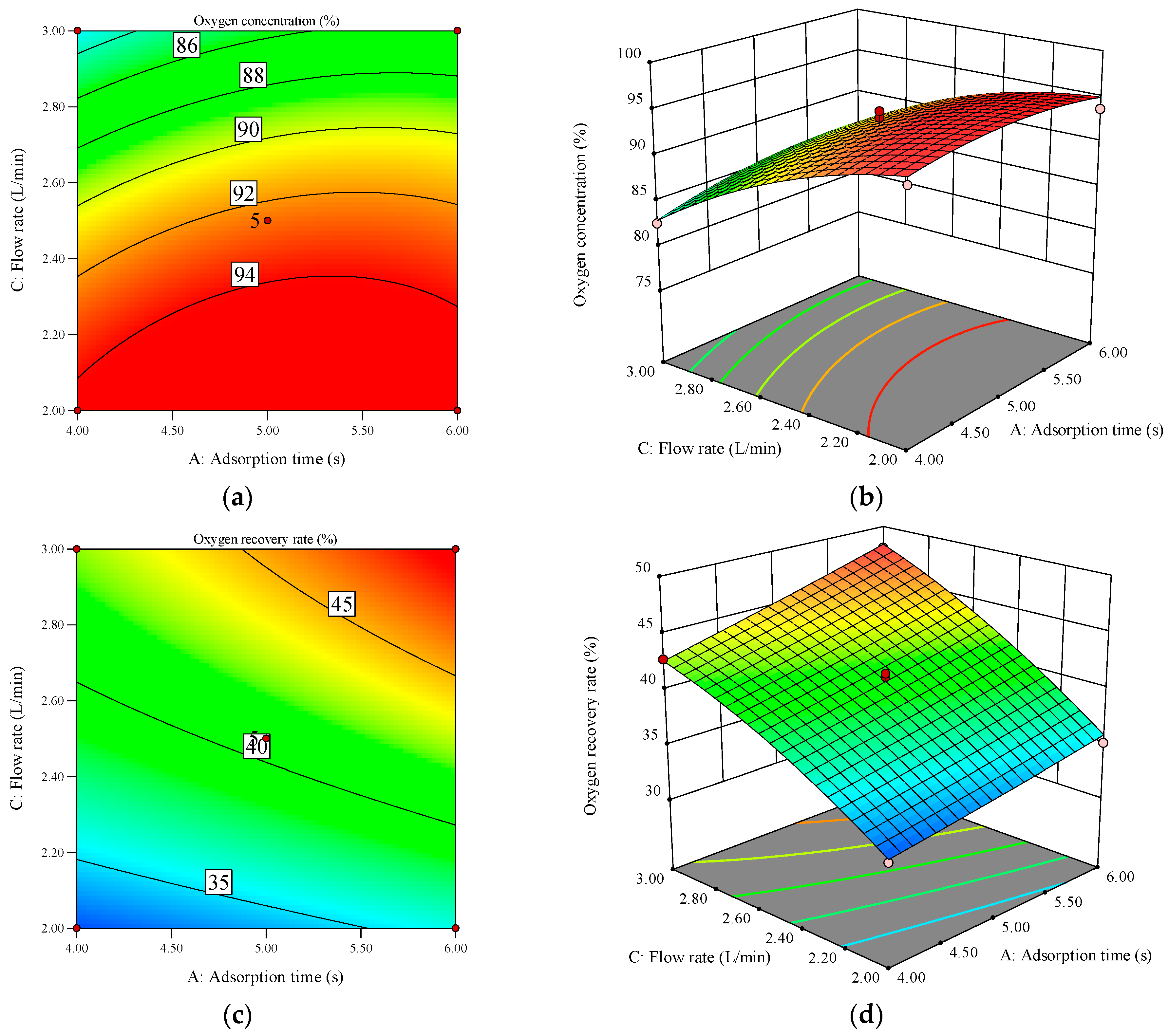
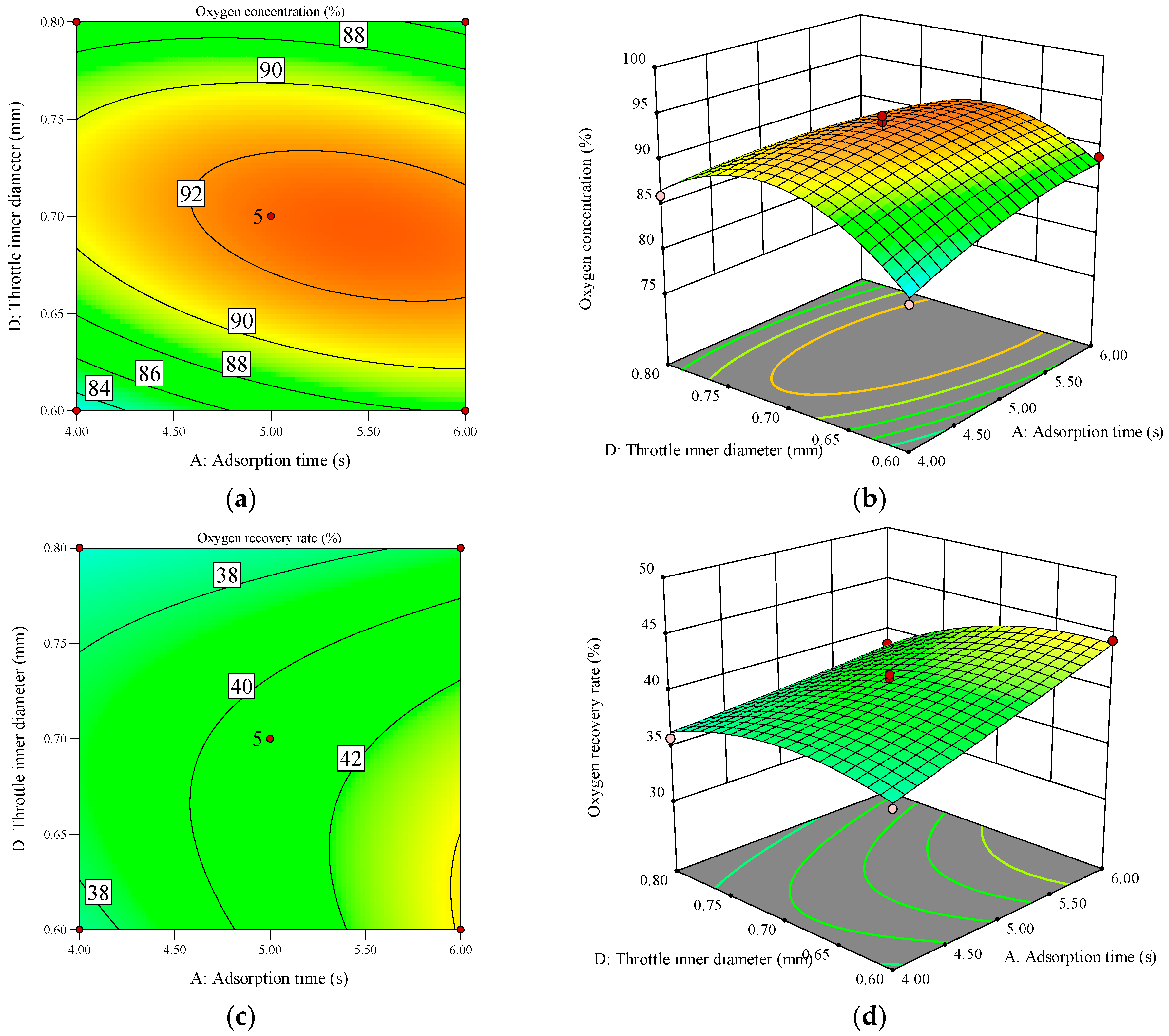
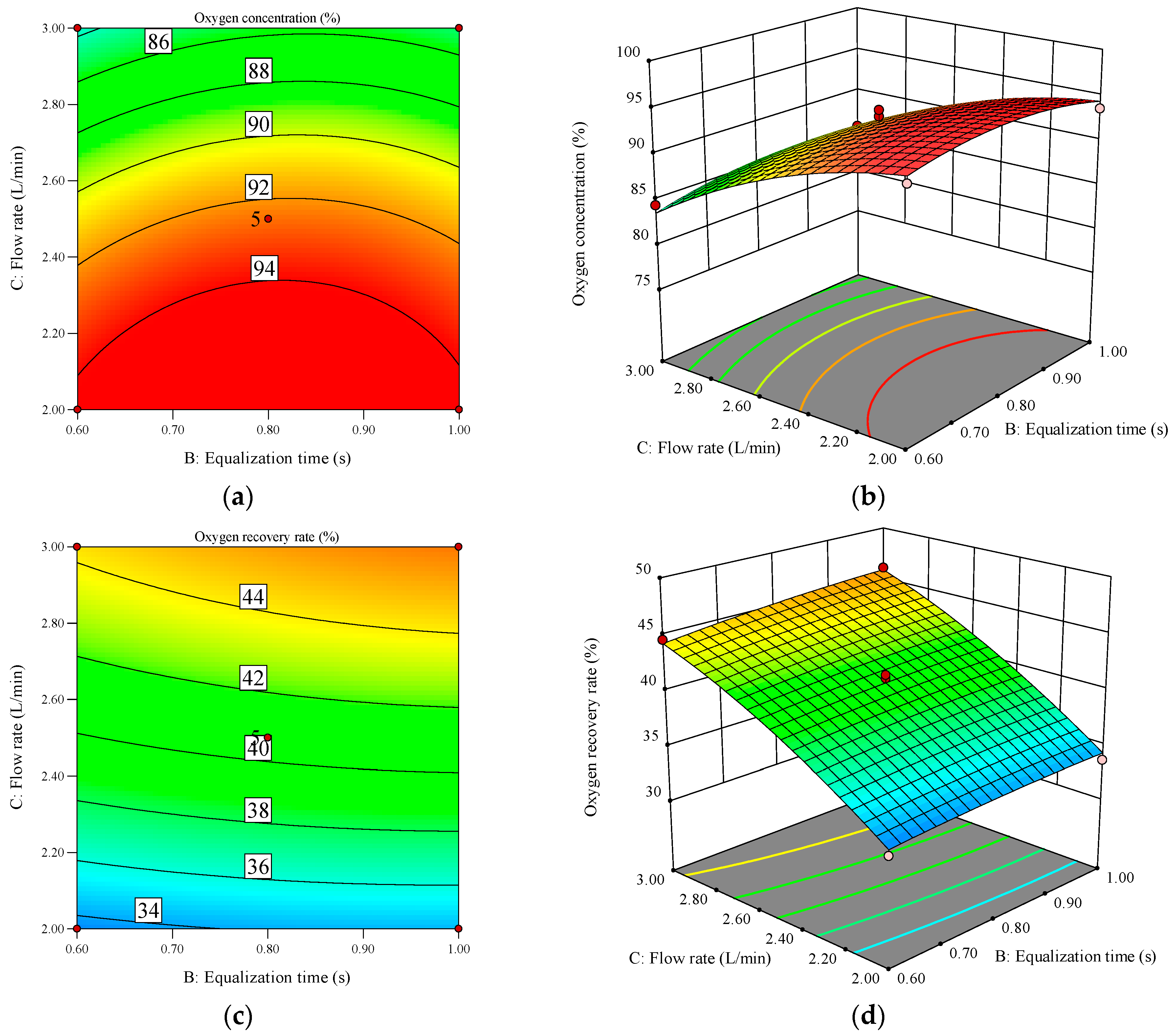
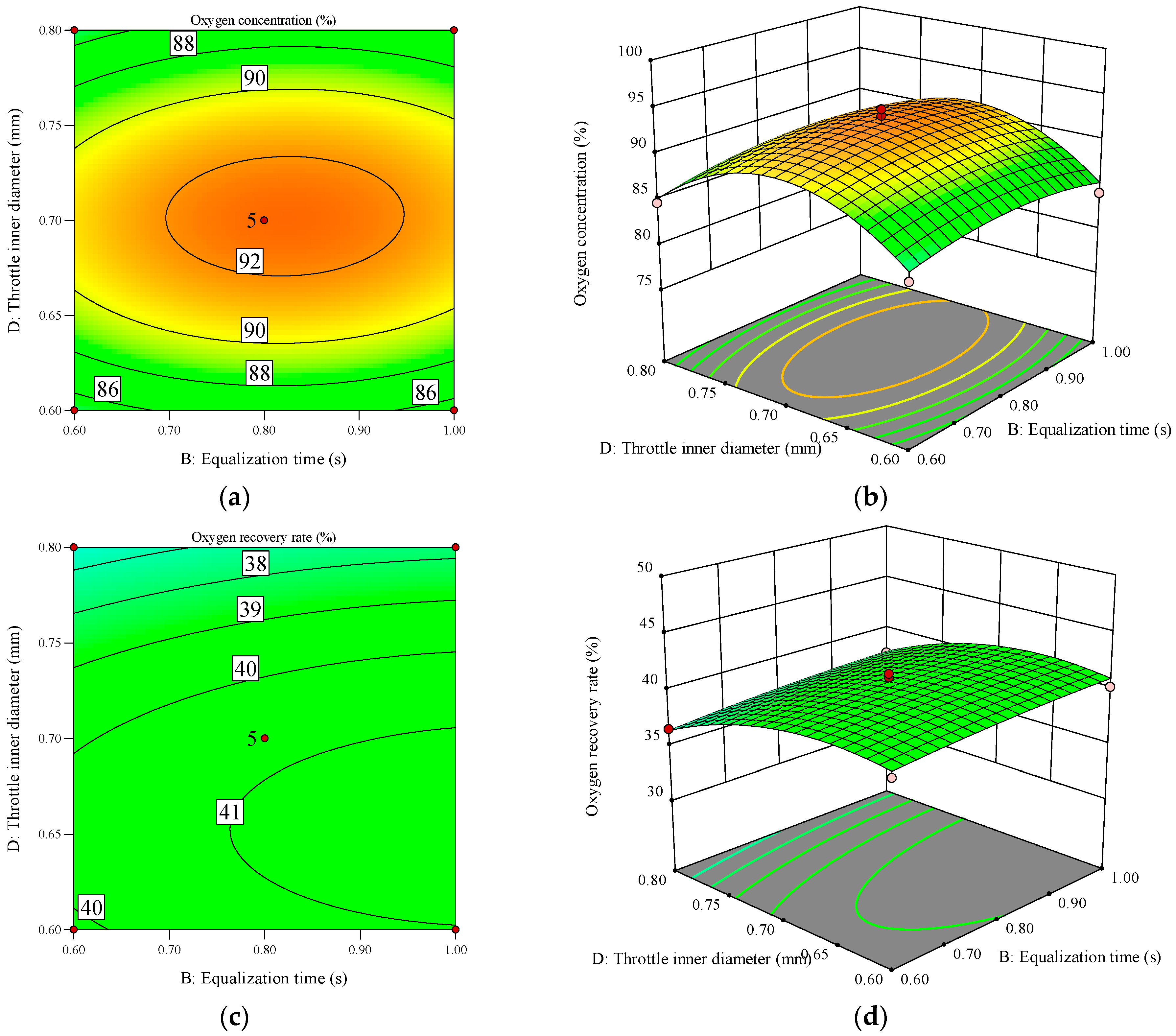
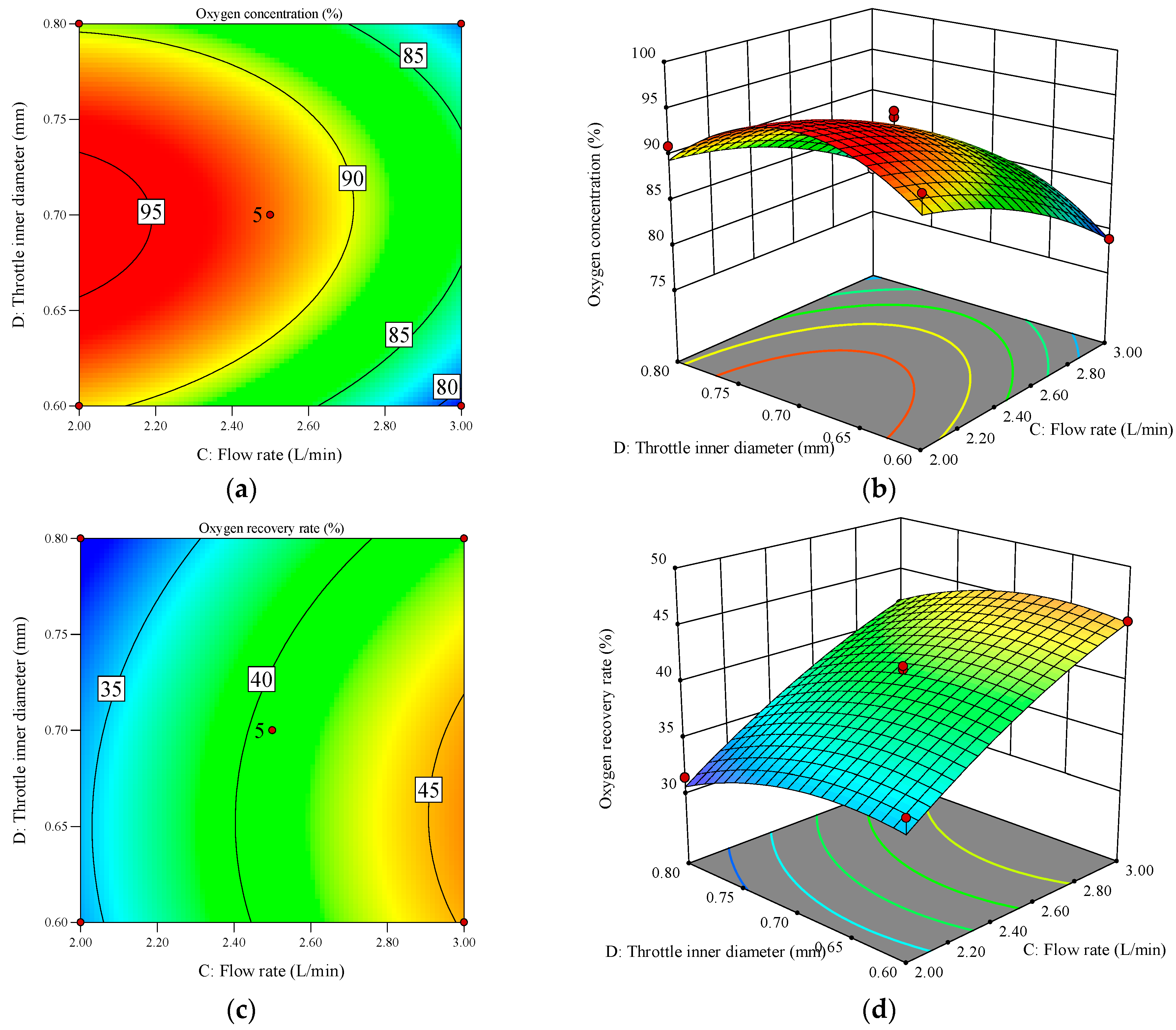
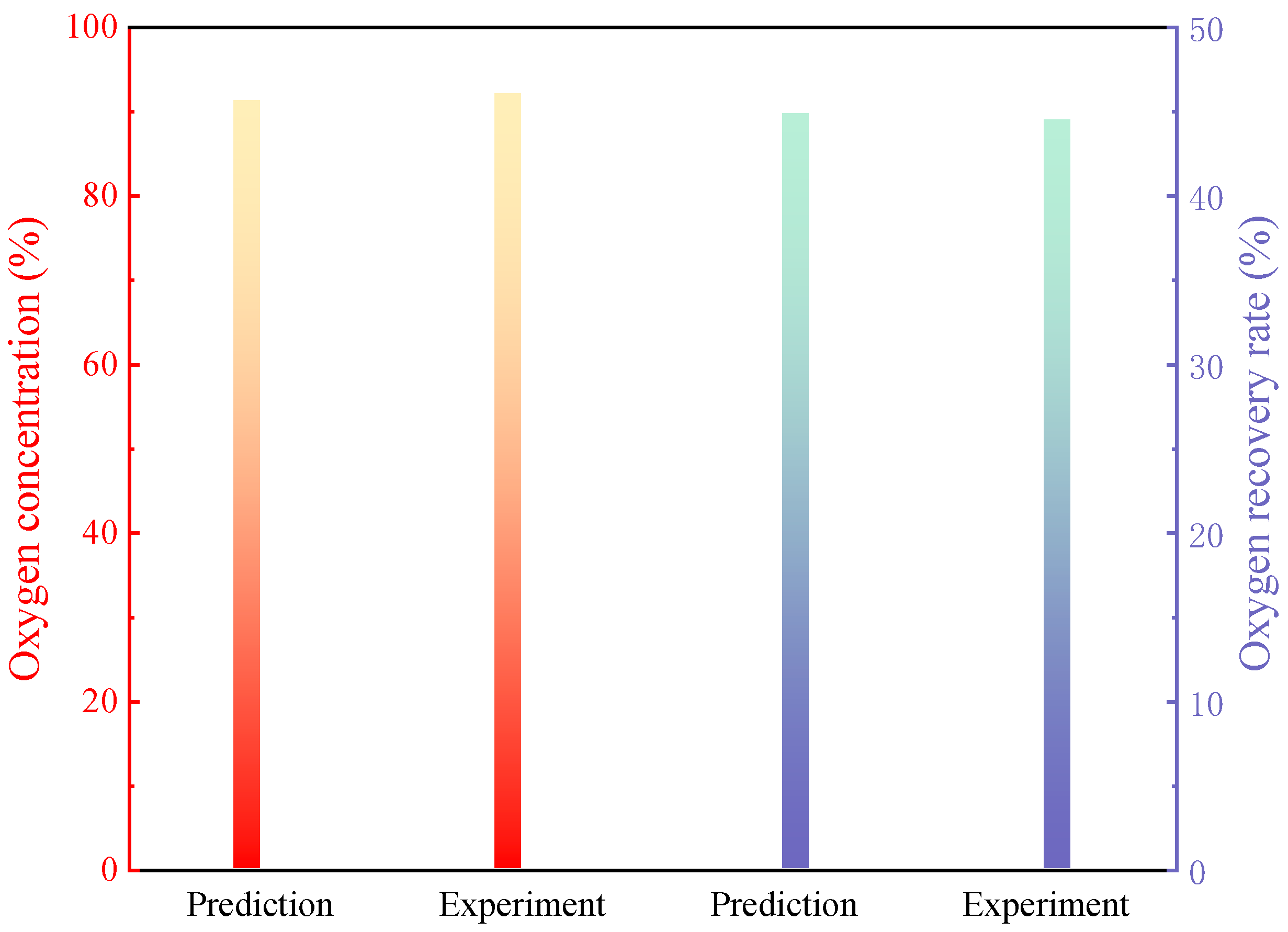
| Property | Unit | JLOX-101A |
|---|---|---|
| Diameter | mm | 0.4~0.8 |
| Device | Model | Parameters | Supplier |
|---|---|---|---|
| Air compressor | ZGK160P2-30 | 160 W, 30 L/min, 20 PSI | SINC Medical Device Co., Ltd., Suqian, China |
| Upper pressure equalizing valve | T153UD-FG | DC12V, N.C. | Taizhou Ours Top Pneumatic Technology Co., Ltd., Taizhou, China |
| 2-position 5-way valve | SNT-06 1L | DC12V, 0.02~0.2 MPa | Ningbo Sinot Pneumatic Machinery Co., Ltd., Ningbo, China |
| Oxygen storage tank | / | inner diameter: 52 mm, height: 100 mm | / |
| Throttler | / | 0.6, 0.7, 0.8 mm | / |
| Mass flowmeter | AST10-DL | 0~5 L/min, ±1.0%F.S, 0.01~0.5 MPa | Asert Instruments (Beijing) Co., Ltd., Beijing, China |
| Oxygen concentration analyzer | BEE-5100 | 10~99.99%Vol, ≤±1%F.S, | Xi’an Bien Electronic Technology Co., Ltd., Xi’an, China |
| Adsorption Bed | Step 1 | Step 2 | Step 3 | Step 4 |
|---|---|---|---|---|
| Bed A | Pressurization and adsorption | Equilibrium pressure | Desorption and purge | Equilibrium pressure |
| Bed B | Desorption and purge | Equilibrium pressure | Pressurization and adsorption | Equilibrium pressure |
| Factor | Level | ||
|---|---|---|---|
| −1 | 0 | 1 | |
| Adsorption time (s) | 4 | 5 | 6 |
| Equalization time (s) | 0.6 | 0.8 | 1 |
| Oxygen flow rate (L/min) | 2 | 2.5 | 3 |
| Throttle inner diameter(mm) | 0.6 | 0.7 | 0.8 |
| Experiment Number | A | B | C | D | Oxygen Concentration (%) | Oxygen |
|---|---|---|---|---|---|---|
| 1 | −1 | −1 | 0 | 0 | 89.22 | 37.7593 |
| 2 | 1 | −1 | 0 | 0 | 91.435 | 42.781 |
| 3 | −1 | 1 | 0 | 0 | 91.27 | 40.1605 |
| 4 | 1 | 1 | 0 | 0 | 91.125 | 43.5554 |
| 5 | 0 | 0 | −1 | −1 | 92.8 | 35.4848 |
| 6 | 0 | 0 | 1 | −1 | 78.93 | 45.2718 |
| 7 | 0 | 0 | −1 | 1 | 91 | 31.4098 |
| 8 | 0 | 0 | 1 | 1 | 80.4 | 41.6267 |
| 9 | −1 | 0 | 0 | −1 | 82.12 | 36.8662 |
| 10 | 1 | 0 | 0 | −1 | 88.8 | 44.3572 |
| 11 | −1 | 0 | 0 | 1 | 86.05 | 35.7354 |
| 12 | 1 | 0 | 0 | 1 | 85.94 | 38.5812 |
| 13 | 0 | −1 | −1 | 0 | 93.63 | 32.9592 |
| 14 | 0 | 1 | −1 | 0 | 93.57 | 33.6052 |
| 15 | 0 | −1 | 1 | 0 | 84.47 | 44.6021 |
| 16 | 0 | 1 | 1 | 0 | 85.67 | 46.1519 |
| 17 | −1 | 0 | −1 | 0 | 93.6 | 32.3073 |
| 18 | 1 | 0 | −1 | 0 | 93.66 | 35.0577 |
| 19 | −1 | 0 | 1 | 0 | 82.57 | 42.7502 |
| 20 | 1 | 0 | 1 | 0 | 85.385 | 47.9404 |
| 21 | 0 | −1 | 0 | −1 | 84 | 39.3023 |
| 22 | 0 | 1 | 0 | −1 | 84.09 | 40.1929 |
| 23 | 0 | −1 | 0 | 1 | 84.68 | 36.5355 |
| 24 | 0 | 1 | 0 | 1 | 85.44 | 37.5952 |
| 25 | 0 | 0 | 0 | 0 | 92 | 40.4818 |
| 26 | 0 | 0 | 0 | 0 | 93.41 | 41.1022 |
| 27 | 0 | 0 | 0 | 0 | 91.22 | 40.1385 |
| 28 | 0 | 0 | 0 | 0 | 92 | 40.4818 |
| 29 | 0 | 0 | 0 | 0 | 94.11 | 41.4102 |
| Source of Variance | Square Sum SS | Degree of Freedom df | Mean Squared SM | F Value | p | Significance |
|---|---|---|---|---|---|---|
| model | 556.73 | 14 | 39.77 | 20.90 | <0.0001 | ** |
| A-Adsorption time | 11.05 | 1 | 11.05 | 5.81 | 0.0303 | * |
| B-Equalization time | 1.16 | 1 | 1.16 | 0.61 | 0.4480 | |
| C-Flow | 308.41 | 1 | 308.41 | 162.09 | <0.0001 | ** |
| D-Throttle inner diameter | 0.64 | 1 | 0.64 | 0.34 | 0.5713 | |
| AB | 1.39 | 1 | 1.39 | 0.73 | 0.4067 | |
| AC | 1.90 | 1 | 1.90 | 1.00 | 0.3349 | |
| AD | 11.53 | 1 | 11.53 | 6.06 | 0.0274 | * |
| BC | 0.40 | 1 | 0.40 | 0.21 | 0.6549 | |
| BD | 0.11 | 1 | 0.11 | 0.059 | 0.8116 | |
| CD | 2.67 | 1 | 2.67 | 1.40 | 0.2556 | |
| A2 | 8.15 | 1 | 8.15 | 4.28 | 0.0574 | |
| B2 | 13.51 | 1 | 13.51 | 7.10 | 0.0185 | * |
| C2 | 21.19 | 1 | 21.19 | 11.14 | 0.0049 | ** |
| D2 | 213.47 | 1 | 213.47 | 112.20 | <0.0001 | ** |
| residual | 26.64 | 14 | 1.90 | |||
| Misfit term | 21.09 | 10 | 2.11 | 1.52 | 0.3649 | |
| pure error | 5.55 | 4 | 1.39 | |||
| Pure difference sum | 583.36 | 28 |
| Source of Variance | Square Sum SS | Degree of Freedom df | Mean Squared SM | F Value | p | Significance |
|---|---|---|---|---|---|---|
| model | 510.7 | 14 | 36.43 | 62.84 | <0.0001 | ** |
| A-Adsorption time | 59.38 | 1 | 59.38 | 102.42 | <0.0001 | ** |
| B-Equalization time | 4.47 | 1 | 4.47 | 7.71 | 0.0149 | * |
| C-Flow | 379.90 | 1 | 379.90 | 655.28 | <0.0001 | ** |
| D-Throttle inner diameter | 33.30 | 1 | 33.30 | 57.45 | <0.0001 | ** |
| AB | 0.66 | 1 | 0.66 | 1.14 | 0.3035 | |
| AC | 1.49 | 1 | 1.49 | 2.57 | 0.1314 | |
| AD | 5.39 | 1 | 5.39 | 9.30 | 0.0086 | ** |
| BC | 0.20 | 1 | 0.20 | 0.35 | 0.5623 | |
| BD | 7.155 × 10−3 | 1 | 7.155 × 10−3 | 0.012 | 0.9131 | |
| CD | 0.046 | 1 | 0.046 | 0.080 | 0.7819 | |
| A2 | 0.059 | 1 | 0.059 | 0.10 | 0.7542 | |
| B2 | 0.36 | 1 | 0.36 | 0.62 | 0.4432 | |
| C2 | 6.36 | 1 | 6.36 | 10.97 | 0.0051 | ** |
| D2 | 20.23 | 1 | 20.23 | 34.90 | <0.0001 | ** |
| residual | 8.12 | 14 | 0.58 | |||
| Misfit term | 7.04 | 10 | 0.70 | 2.62 | 0.1828 | |
| pure error | 1.07 | 4 | 0.27 |
| Parameters | Adsorption Time (s) | Pressure Equalization Time (s) | Flow Rate (L/min) | Throttle Inner Diameter (mm) |
|---|---|---|---|---|
| Values | 6 | 0.8 | 2.6 | 0.67 |
Disclaimer/Publisher’s Note: The statements, opinions and data contained in all publications are solely those of the individual author(s) and contributor(s) and not of MDPI and/or the editor(s). MDPI and/or the editor(s) disclaim responsibility for any injury to people or property resulting from any ideas, methods, instructions or products referred to in the content. |
© 2024 by the authors. Licensee MDPI, Basel, Switzerland. This article is an open access article distributed under the terms and conditions of the Creative Commons Attribution (CC BY) license (https://creativecommons.org/licenses/by/4.0/).
Share and Cite
Li, Y.; Zhao, L.; Li, S.; Bei, J.; Zhong, H.; Liu, Y.; Zhang, Q.; Sun, N.; Li, Z.; Wang, S.; et al. Experimental Study on Vehicle Pressure Swing Adsorption Oxygen Production Process Based on Response Surface Methodology. Separations 2024, 11, 267. https://doi.org/10.3390/separations11090267
Li Y, Zhao L, Li S, Bei J, Zhong H, Liu Y, Zhang Q, Sun N, Li Z, Wang S, et al. Experimental Study on Vehicle Pressure Swing Adsorption Oxygen Production Process Based on Response Surface Methodology. Separations. 2024; 11(9):267. https://doi.org/10.3390/separations11090267
Chicago/Turabian StyleLi, Ye, Lisheng Zhao, Shuguang Li, Jianqiu Bei, Haotu Zhong, Yingshu Liu, Quanli Zhang, Ningqi Sun, Ziyi Li, Shifeng Wang, and et al. 2024. "Experimental Study on Vehicle Pressure Swing Adsorption Oxygen Production Process Based on Response Surface Methodology" Separations 11, no. 9: 267. https://doi.org/10.3390/separations11090267








